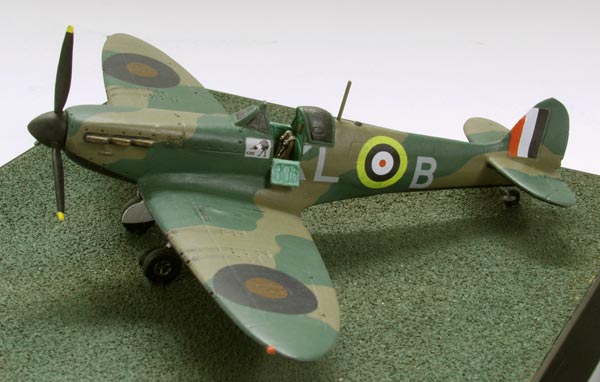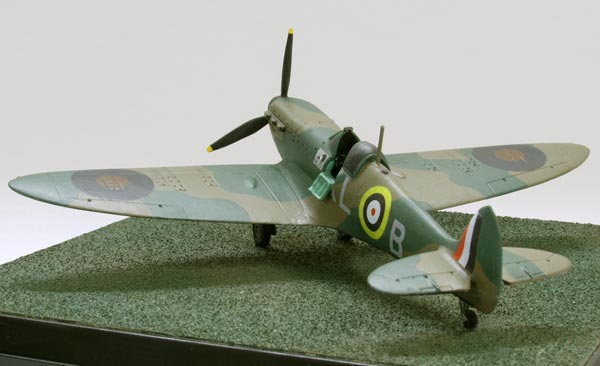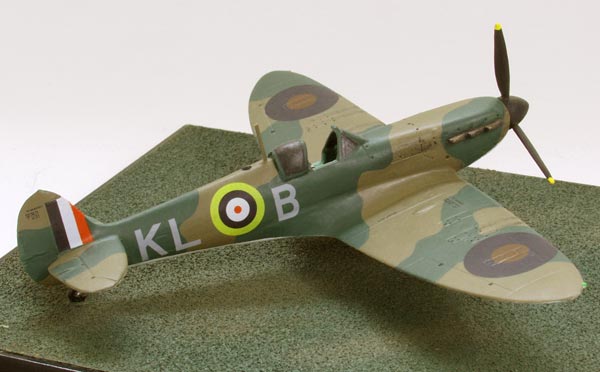Supermarine Spitfire Mk I
Supermarine Spitfire Mk I N3183 KL-B ‘KIWI’
54 Squadron, Plt Off Alan Deere, Hornchurch, 1940.
Alan Deere was born in Auckland on December the 12th 1917. In April 1937 he applied for a short service commission in the RAF and he sailed for the UK on September 23 in the RMS Rangitane.
In November he began his training at 13 E&RFTS, White Waltham, moved to 6 FTS, Netheravon in late January 1938 and joined 54 Squadron in September. The squadron began to receive Spitfire Mk Is in March 1939 and on a flight in May Deere was overcome by anoxia and lost consciousness. His aircraft dived and he came to just in time to pull out hiit he suffered a broken ear drum and was off flying for three months.
On May the 23rd 1940 Deere and Pilot Officer J L Allen escorted Flight Lieutenant J A Leathart. who flew a Master to Calais/Marek airfield to pick up the CO of 74 Squadron. Squadron Leader F L White, who had made a forced-landing there. The rescue was made and Deere shot down two Bf 109s and damaged another. Later the same day he destroyed a third.
On May the 24th Deere shot down a Bf 110 and on the 26th two more. He was leading a dawn patrol on the 28th. Unable to keep up with the other two Hornchurch squadrons, the Spitfire Mk Is crossed the Belgian coast alone. Sighting a Do 17. Deere gave chase with three members of his flight. He damaged the bomber but was hit by return fire and with his glycol tank holed and producing smoke, he decided to make a forced-landing on a beach, he was knocked unconcsious as the Spitfire Mk I ploughed through the sand. After coming to. he got out of the now burning aircraft and was taken by a soldier to Oost-Dunkerke. where he had his head injury dressed. Deere decided to make for Dunkirk, commandeered a bicycle and was eventually picked up by British soldiers, heading for Dunkirk in a lorry. They abandoned it on the outskirts because of congestion on the road. Deere got on a boat back to Dover, caught a train to London, went by Underground to Elm Park and arrived back at Hornchurch nineteen hours after he had taken off. He was awarded the DFC (12.6.40), which was presented to him by the King in a ceremony at Hornchurch on the 27thof June 1940.
Deere shared in the unconfirmed destruction of a Ju 88 on June the 17th. He destroyed a Bf 109 on July the 9th and after colliding with another, he crash-landed in a cornfield, escaping with minor injuries. On August the 11th he destroyed a Bf 109, on the 12th two Bf 109s and a Bf 110, on the 15th he destroyed another Bf 109 but had to bale out at a very low level after being chased back across the Channel by two German fighters. He escaped with a slight fracture of the wrist and after an overnight stay at the Queen Victoria Hospital, East Grinstead he returned to Hornchurch.
Deere was shot down by a Spitfire Mk I on August the 28th and baled out. On the 30th he probably shot down a Do 17. The next day he was the pilot of one of three Spitfires caught in a bombing attack as they were taking off from Hornchurch. Deere’s aircraft was thrown on to its back and he was left suspended in his harness. He was released by one of the other two pilots involved, Pilot Officer E F Edsall, who, despite leg injuries, crawled across and released Deere, who then took his rescuer to Station Sick Quarters.
On September the 3rd Deere probably destroyed a Bf 110. He was awarded a Bar to the DFC (6.9.40). In January 1941 he was made Operations Room Controller at Catterick. His portrait was painted by Orde in February. Deere joined 602 Squadron at Ayr on May the 7th. as a Flight Commander. On June the 5th he crash-landed on the clift top at the Heads of Ayr after his engine seized.
On August the 1st 1941 he took command of 602 Squadron and on the same day he destroyed a Bf 109 over Gravelines. He was posted away in January 1942 and sent to America to lecture on fighter tactics. Deere returned to operations on May the 1st. taking command of 403 (RCAF) Squadron at North Weald. In August he was posted to HQ 13 Group on staff duties. He went for a course at RAF Staff College, after which he returned to 13 Group.
In February 1943, desperate to return to operations. Deere went as a supernumerary to 611 Squadron at Biggin Hill. Whilst there he destroyed a FW 190. He was given command of the Kenley Wing but the posting was changed and he went as Wing Leader to Biggin Hill. Deere was awarded the DSO (15.7.43). He led the Wing until September the 15th 1943, when he became ill and was admitted to hospital. He then had 22 confirmed victories, 10 probables and a further 18 enemy aircraft damaged.
Deere went to CGS, Sutton Bridge to command the Fighter Wing. In March 1944 he got a staff job at 11 Group and in early May he took command of 145 (French) Airfield 2nd TAF at Merston. He led the Wing over the invasion bridgehead early on the morning of D-Day. The Wing moved to the Continent later in June and Deere was posted away soon afterwards to HQ 84 Group Control Centre as Wing Commander Plans.
In July 1945 he was appointed Station Commander at Biggin Hill. He was granted a Permanent Commission in August and posted to command the Polish Mustang Wing at Andrews Field, Essex. When the Wing was disbanded in October 1945, he became Station Commander at Duxford.
Deere held a series of appointments and commands in the post-war RAF prior to his retirement on December the 12th 1967. as an Air Commodore. He received the DFC (US), the C de G (Fr), was made an OBE (1.6.45) and was ADC to the Queen in 1962.
Al Deere died September 20, 1995
APO 9.1.38 PO 28.10.38 FO 28.7.40 FL 28 7.41 SL 14.6.43 SL 1.9.45
WC 1.7.51 GC 1.1.58 AC 1.7.64
Ref: Men of the Battle of Britain by Kenneth G. Wynn (CCB Publications)
Scale 1:72 Wingspan 6.25″ (156 mm)
Base size 6.37″ (162 mm) square (No. 4)
Weight not including base 7.25 ozs (212 grams)
Total number of models produced 73




